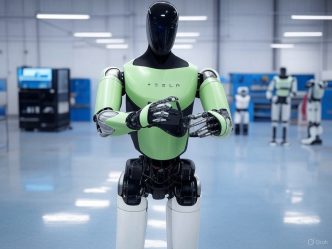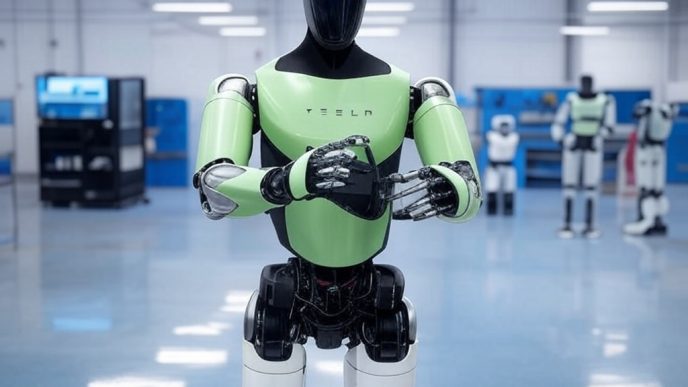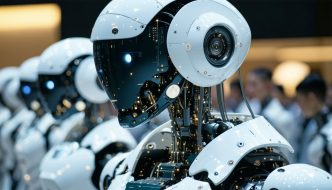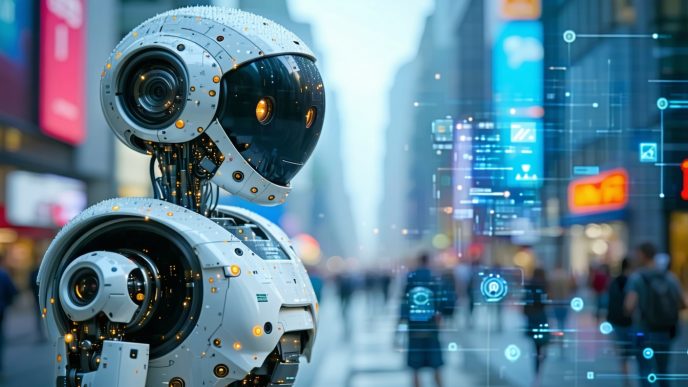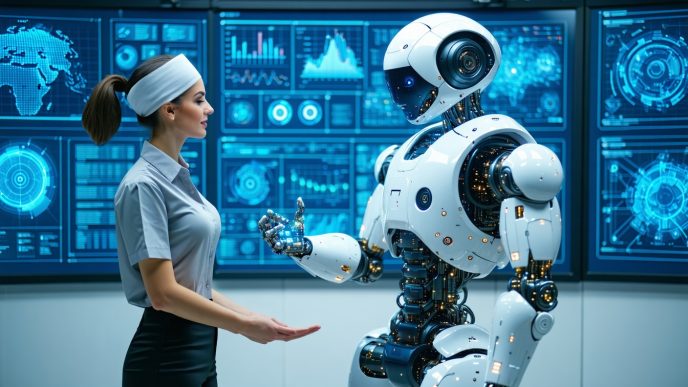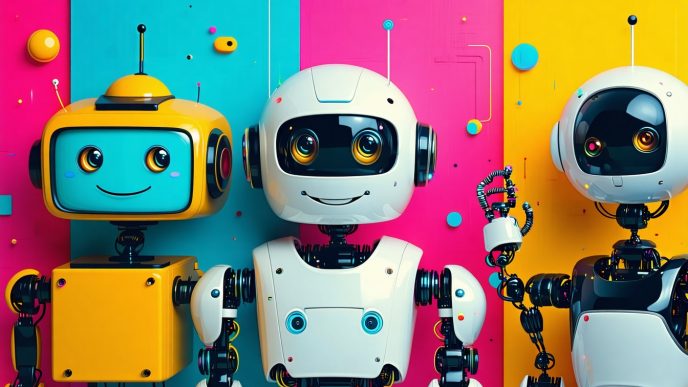Understanding Humanoid Robots
Overview of Humanoid Robots
Humanoid robots are designed to mimic human appearance and behavior, making them unique among robotic systems. They possess a head, torso, arms, and legs, showcasing features that allow for human-like interaction. These robots can perform various tasks, ranging from basic functions, like communication, to complex activities, such as assisting in healthcare or education.
The design of humanoid robots often involves intricate technologies, including sensors and actuators, to facilitate movement and interaction. For example, robots like the tesla optimus robot and figure 01 robot exhibit advanced capabilities in navigation and human interaction.
| Feature | Description |
|---|---|
| Appearance | Mimics human form |
| Functionality | Performs tasks and interacts |
| Technologies Used | Sensors, actuators, AI models |
| Applications | Healthcare, education, security |
Importance of Emotional Intelligence in Consumer Robots
Emotional intelligence plays a critical role in the effectiveness of consumer robots. This capability allows robots to recognize, interpret, and respond to human emotions appropriately. In the context of humanoid robots, emotional intelligence enhances their ability to interact with users in a more relatable manner, improving user experience and satisfaction.
The integration of emotional intelligence can lead to various benefits, such as:
- Improved Interaction: Robots that can understand human emotions foster more meaningful communication.
- Enhanced User Trust: A robot that demonstrates empathy or understanding can build better relationships with users.
- Adaptability: Emotional intelligence enables robots to adjust their responses based on the user’s emotional state.
As technology advances, the demand for emotionally intelligent robots is increasing, especially in sectors like healthcare and companionship. Initiatives like emotion recognition in robots are vital for developing robots that can effectively serve in impactful roles.
The focus on emotional intelligence in humanoid robots emphasizes the need for a deeper understanding of human behavior, improving integration into daily life. Advances in this area contribute to the ongoing evolution of models like the Xiaomi CyberOne, demonstrating the significance of incorporating emotions in robotics.
Introduction to Xiaomi CyberOne
An Overview of Xiaomi CyberOne
Xiaomi CyberOne represents a significant step forward in the field of humanoid robotics. Designed as a dual-purpose companion, it combines advanced technology with a friendly appearance, making it suitable for various applications in both home and commercial environments. Its design emphasizes not only functionality but also the ability to interact with humans on an emotional level.
Key Features of Xiaomi CyberOne
The Xiaomi CyberOne boasts several noteworthy features that enhance its practicality and user experience. Below are some of the critical specifications:
| Feature | Description |
|---|---|
| Height | 177 cm |
| Weight | 52 kg |
| Movement Capabilities | 3D bipedal locomotion |
| Sensors | Advanced sensors for environmental awareness |
| Emotional Intelligence | Capable of recognizing and responding to human emotions |
These features underscore the robot’s versatility, from assisting with daily chores to providing companionship.
Emotional Intelligence in Xiaomi CyberOne
Emotional intelligence is a key component of the Xiaomi CyberOne. It incorporates various technologies that allow it to recognize human emotions through facial expressions and vocal tones. This capability enables the robot to adjust its responses accordingly, thereby creating a more engaging and personalized interaction with users.
For example, if the Xiaomi CyberOne detects that someone is sad, it can respond with uplifting messages or adjust its behavior to offer comfort. This advanced emotional responsiveness positions the CyberOne as not just a machine, but a potential partner in emotional support, blurring the lines between technology and companionship.
Understanding how emotional intelligence enhances the user experience in robots like the Xiaomi CyberOne is crucial. For insights on emotional responses in robotics, refer to our article on emotion recognition in robots.
The Role of Emotional Intelligence in Consumer Robotics
Emotional intelligence in robots is a critical feature that enhances their interaction capabilities. This section discusses the benefits and applications of emotional intelligence in consumer robotics, particularly in models like the Xiaomi CyberOne.
Benefits of Emotional Intelligence in Robots
Implementing emotional intelligence in robots offers numerous advantages. Here are some of the key benefits:
| Benefit | Description |
|---|---|
| Improved Interaction | Robots with emotional intelligence can engage in more meaningful and relatable conversations with users. |
| Enhanced User Experience | Their ability to understand and respond to emotions fosters better user satisfaction. |
| Increased Trust | Emotional intelligence can help in building a rapport between humans and robots, leading to greater trust. |
| Practical Applications | Such robots can effectively assist in various settings, including homes, hospitals, and schools. |
Armed with emotional understanding, robots can respond appropriately in various scenarios, making them more effective companions and assistants. This is particularly valuable in contexts such as humanoid robots for elder care and humanoid robots for companionship.
Application of Emotional Intelligence in Consumer Robots
The applications of emotional intelligence in consumer robots are vast. Here are some notable applications:
| Application Area | Description |
|---|---|
| Elderly Care | Emotional robots can offer companionship and monitor the emotional state of seniors, providing alerts in case of distress. |
| Education | Robots equipped with emotional cues can facilitate learning by adapting to students’ emotional responses. |
| Customer Service | In retail or hospitality, emotionally intelligent robots can engage with customers, providing assistance tailored to their mood. |
| Home Assistance | Robots that understand human emotions can adapt their responses during everyday tasks, making them more user-friendly. |
For instance, the Xiaomi CyberOne can utilize its emotional intelligence to create responsive interactions, contributing to improved user experiences in various environments. Exploring robots like the Tesla Optimus or the Apptronik Apollo also highlights how emotional features are becoming increasingly important in consumer robotics. For more comparisons, visit tesla optimus vs figure 01 or learn about other humanoid innovations in the field, such as the agility digit robot.
By incorporating emotional intelligence, consumer robots like the Xiaomi CyberOne can bridge the gap between machines and humans, enhancing functionality and user satisfaction.
Design and Functionality
Design Considerations in Humanoid Robots
Design plays a crucial role in the development of humanoid robots. The aesthetics, functionality, and usability are all key factors that developers must consider. These robots must resemble human form to facilitate better interaction and emotional connection with users. The following table summarizes essential design considerations:
| Design Aspect | Description |
|---|---|
| Human-like Appearance | Robots are designed to mimic human features and movements to ensure relatability. |
| Material Durability | Use of lightweight yet strong materials to support versatility while ensuring safety. |
| Mobility | Incorporating advanced locomotion systems for agile movement. Considerations for walking, sitting, and reaching functions are critical. |
| Interaction Interfaces | Integration of voice recognition and touch-sensitive part to enhance user interaction. For more on this, refer to our article on voice interfaces in humanoid robots. |
| Safety Features | Implementation of safety systems designed to prevent harm to users and property. Explore more about this in our piece on humanoid robot safety systems. |
Attention to these design details determines how well the humanoid robot can perform its intended functions while ensuring user safety and satisfaction.
How Emotional Intelligence is Incorporated in Xiaomi CyberOne
Xiaomi CyberOne stands out in the realm of humanoid robots due to its unique incorporation of emotional intelligence. This capability allows the robot to not just perform tasks but also to interact meaningfully with users.
The following features demonstrate how emotional intelligence is integrated into Xiaomi CyberOne:
| Feature | Description |
|---|---|
| Emotion Recognition | Utilizes sensors and AI to identify user emotions based on facial expressions and voice tone. This helps the robot adapt its responses accordingly. For further details on this technology, see our article on emotion recognition in robots. |
| Adaptive Communication | The robot adjusts its dialogues based on user emotions, ensuring appropriate reactions and engagement levels. |
| Social Interaction Skills | Designed with the ability to engage in human-like conversations, making interactions feel more natural. |
| Feedback Mechanism | Learns from past interactions to improve future responses and provide more personalized engagement. |
By offering these advanced emotional features, Xiaomi CyberOne positions itself as a leader in creating robots that connect with users on a personal level, enhancing both functionality and user experience.
Interactions and Applications
Understanding the interactions and applications of the Xiaomi CyberOne is essential for appreciating its role in consumer robotics. This humanoid robot is designed not only to perform tasks but also to engage with users on a more emotional level.
Human-Robot Interaction
The efficiency of human-robot interactions is significantly influenced by the emotional intelligence embedded within robots like the Xiaomi CyberOne. Through advanced sensors and algorithms, this robot can recognize and respond to human emotions, enhancing user experience.
The following table outlines key features that facilitate effective human-robot interaction:
| Feature | Description |
|---|---|
| Emotion Recognition | Ability to interpret user emotions through facial recognition and tone analysis. |
| Conversational Skills | Engages users with natural language processing for more authentic exchanges. |
| Adaptive Responses | Adjusts behavior based on the emotional state of the user, promoting comfort and understanding. |
Effective emotional intelligence allows the Xiaomi CyberOne to provide companionship, support, and utility, making interactions more engaging and relevant.
Real-World Applications of Xiaomi CyberOne
Xiaomi CyberOne is not confined to singular functions; its versatility allows for various applications in everyday life. These applications can significantly enhance user convenience and efficiency across multiple domains, as demonstrated in the following table:
| Application | Description |
|---|---|
| Home Assistance | Performs chores, assists with daily tasks, and supports household management. |
| Companionship | Provides emotional support and companionship for users, particularly the elderly. |
| Educational Support | Acts as an interactive learning assistant for children, enhancing educational engagement. |
| Healthcare | Assists healthcare professionals in monitoring patient needs and delivering information. |
The innovative capabilities of the Xiaomi CyberOne create new possibilities for integrating humanoid robots into various aspects of life, ultimately improving quality of living and fostering deeper connections. For more insights into the potential of humanoid robots in specific niches, such as humanoid robots for home use and humanoid robots in healthcare, readers can explore further.
Challenges and Future Developments
Current Challenges in Emotional Intelligence for Robots
Despite advancements in humanoid robots like the Xiaomi CyberOne, there are still significant challenges in integrating emotional intelligence into robotic systems. These challenges include:
- Complexity of Human Emotions
- Understanding and accurately interpreting human emotions can be exceedingly complex. Emotions are often nuanced and influenced by various factors, making it difficult for robots to respond appropriately in all situations.
- Limitations in Technology
- Current sensors and algorithms may not fully capture the depth and breadth of human emotional expressions. For instance, while tools for emotion recognition in robots have improved, they still encounter difficulties in processing subtle cues.
- User Acceptance
- Many users may be skeptical of robots possessing emotional intelligence. The perception of robots must shift for widespread adoption, as people tend to balance unease with trust in intelligent machines.
- Ethical Considerations
- The integration of emotional intelligence raises ethical questions about robot interactions with humans. Concerns about manipulation, privacy, and the impact on human relationships must be addressed.
| Challenge | Description |
|---|---|
| Complexity of Emotions | Nuanced emotions can be hard for robots to interpret. |
| Technology Limitations | Current tech may not capture emotional depth accurately. |
| User Acceptance | Skepticism towards emotional robots affects trust and use. |
| Ethical Considerations | Issues related to manipulation and privacy must be managed. |
Future Developments and Trends in Consumer Robotics
Looking to the future, several developments and trends could shape the evolution of emotional intelligence in consumer robotics. These include:
- Advancements in AI Models
- The use of cutting-edge AI models in humanoid robots can enhance their ability to recognize and respond to complex emotional signals from users.
- Improved Sensors
- Enhanced sensors equipped with capabilities to analyze facial expressions, vocal tones, and contextual cues will lead to more natural interactions between humans and robots.
- Customization of Interactions
- Future humanoid robots will likely allow for customized personalities, enabling users to choose how their robots interact with them based on desired emotional responses. Developments in humanoid robot customization will play a crucial role here.
- Integration of Social Norms
- Future robots may incorporate social norms based on cultural understanding, enhancing their compatibility with users across different regions.
- Safety and Ethics
- As emotional intelligence grows, so will the focus on ensuring safe interactions. Establishing guidelines for robot emotions and ethics will be paramount to allow users to feel secure.
- Artificial Empathy
- Emerging technologies may enable robots to simulate empathy, responding to user feelings more authentically, potentially transforming caregiving and companionship roles for robots.
| Future Development | Description |
|---|---|
| Advancements in AI Models | Better emotional recognition through sophisticated AI systems. |
| Improved Sensors | Enhanced technology for analyzing emotional cues accurately. |
| Customization of Interactions | Personalized robot interactions based on user preferences. |
| Integration of Social Norms | Robots will adapt to cultural and social expectations. |
| Safety and Ethics | Developing guidelines for ethical robot-human interactions. |
| Artificial Empathy | Simulating empathy to connect effectively with users. |
The Xiaomi CyberOne showcases promising capabilities in emotional intelligence, paving the way for innovations in how humans and robots interact in the future. Understanding and overcoming these challenges will be vital for the success of consumer robotics. For more information on consumer robotics, explore articles on humanoid robots for home use and humanoid robots in healthcare.



